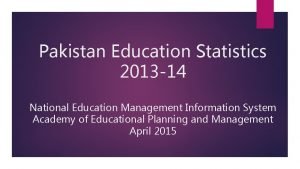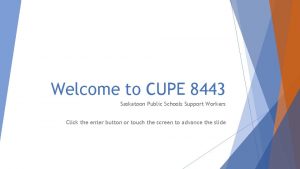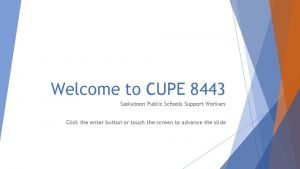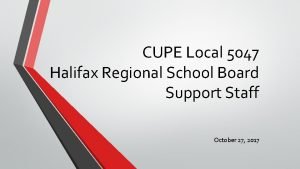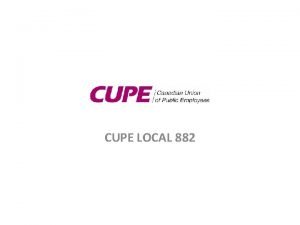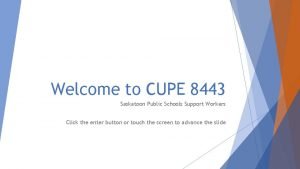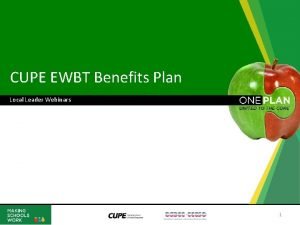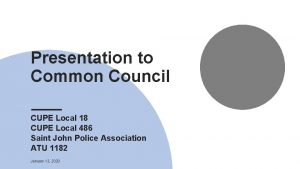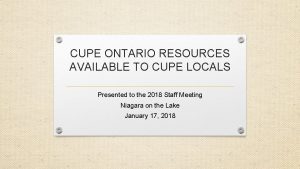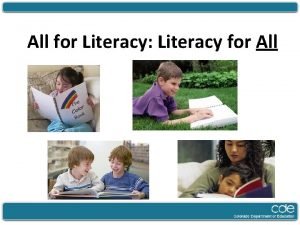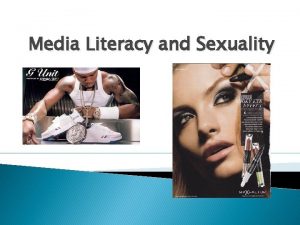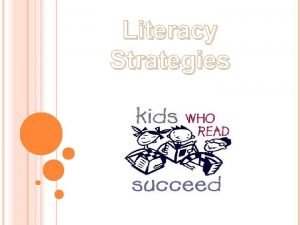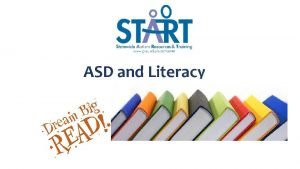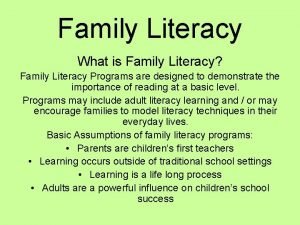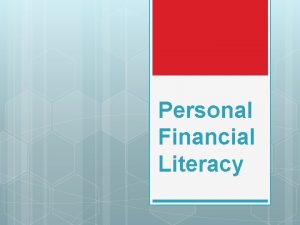INTERNATIONAL LITERACY STATISTICS 2013 Presentation to the CUPE































- Slides: 31

INTERNATIONAL LITERACY STATISTICS 2013 Presentation to the CUPE Literacy Working Group and the CUPE Learners’ Council Brigid Hayes, November 27, 2013

Agenda • Overview of PIAAC • Main Results • Positive Aspects • Some Questions and Challenges • Key “Takeaways”

Overview of PIAAC • PIAAC = Programme for the International Assessment of Adult Competencies • Lead is the Organisation for Economic Cooperation and Development (OECD) • OECD uses the term “Survey of Adult Skills” with PIAAC being the overall research program; in Canada more likely to see the term PIAAC used • Successor survey to the International Adult Literacy and Skills Survey (2003), International Adult Literacy Survey (1994) and Literacy Skills Used in Daily Activities (1989)

International Context • 166, 000 adults aged 16 – 65 surveyed • August 2011 – March 2012 • 22 countries • Australia, Austria, Belgium (Flanders), Canada, the Czech Republic, Denmark, Estonia, Finland, France, Germany, Ireland, Italy, Japan, Korea, the Netherlands, Norway, Poland, the Slovak Republic, Spain, Sweden, the United Kingdom (England Northern Ireland), the United States, Cyprus and the Russian Federation • Next round – 9 more countries • Chile, Greece, Indonesia, Israel, Lithuania, New Zealand, Singapore, Slovenia, and Turkey • Result to be released in 2016 • A third round – May 2014

Canadian Context • Lead federal departments are Employment and Social Development Canada and Statistics Canada • Provinces and territories participated through the Council of Ministers of Education (CMEC) • 27, 285 respondents • Proportionally, Canada had the largest survey population due to oversampling – immigrants, official language minorities, Aboriginal peoples • Excludes on-reserve Aboriginal populations

Skills Assessed • 2013 • Literacy • Numeracy • Problem Solving in Technology Rich Environments • 2003 • Prose Literacy • Document Literacy • Numeracy • Problem Solving • 1993 • Prose Literacy • Document Literacy • Quantitative Literacy

Literacy • Literacy is defined as the ability to understand, evaluate, use and engage with written texts to participate in society, achieve one’s goals, and develop one’s knowledge and potential. • Literacy encompasses a range of skills from the decoding of written words and sentences to the comprehension, interpretation, and evaluation of complex texts. It does not, however, involve the production of text (writing). • Information on the skills of adults with low levels of proficiency is provided by an assessment of reading components that covers text vocabulary, sentence comprehension and passage fluency.

Numeracy • Numeracy is defined as the ability to access, use, interpret and communicate mathematical information and ideas in order to engage in and manage the mathematical demands of a range of situations in adult life. • To this end, numeracy involves managing a situation or solving a problem in a real context, by responding to mathematical content and concepts represented in multiple ways.

Problem Solving In Technology-rich Environments (PS-TRE) • Problem solving in technology-rich environments is defined as the ability to use digital technology, communication tools and networks to acquire and evaluate information, communicate with others and perform practical tasks. • The assessment focuses on the abilities to solve problems for personal, work and civic purposes by setting up appropriate goals and plans, and accessing and making use of information through computers and computer networks.

Main Outcomes - Literacy • Canada ranks at the OECD average in literacy • Alberta and Ontario score above the OECD average • Quebec, New Brunswick, Newfoundland Labrador, Northwest Territories, Nunavut scored below the OECD average • Canada has a higher proportion at the highest and lowest levels of literacy • 14% at level 4/5 • 17% at level 1 or below

Ranking of Countries, 1994, 2003, 2013, Prose and Literacy Scales IALS (1994) 1 2 3 4 5 6 7 8 9 10 11 12 13 14 15 16 17 18 19 20 21 22 23 24 Norway Netherlands Canada New Zealand Australia United States Switzerland Hungary IALSS (2003) Norway Canada Netherlands Australia New Zealand Switzerland Hungary United States PIAAC (2013) Japan Finland Netherlands Australia Sweden Norway Estonia Flanders (Belgium) Czech Republic Slovak Republic Canada Average Korea England/N. Ireland Denmark Germany United States Austria Cyprus Poland Ireland France Spain Italy


Main Outcomes - Numeracy • Canada ranks below the OECD average in numeracy • No province or territory ranked above OECD average • 13% of respondents scored at level 4/5 • 23% of respondents scored at level 1 or below


Main Outcomes – PS-TRE • Assessment was done on a computer – 81% of respondents participated in this assessment • The percentage of Canadian respondents participating in the PS-TRE element was higher than the OECD average • Canada is above the OECD average in PS-TRE – 37% scored at level 2 or 3 • All provinces and territories scored at or above the OECD average except Nunavut • 30% scored at level 1 • 15% scored at below level 1


Other Highlights • Literacy and numeracy scores are highest among those 25 to 34 • Women and men have similar literacy skills with men having higher numeracy skills • Higher education is association with greater literacy, numeracy and PS-TRE skills • The employed have stronger literacy and numeracy skills • The unemployed and the “not in the labour force” population have similar literacy and numeracy skills, but the PS-TRE skills of the unemployed are higher than those not in the labour force

Selected Populations • Aboriginal populations generally score lower on literacy, numeracy and PS-TRE, but there are variations across provinces/territories • Immigrants score lower on these skills than the Canadian born population. Recent and established immigrants skills are similar in literacy and numeracy but at the national level a larger proportion of established immigrants did not take the computer based assessment for PS-TRE • Official language minority populations tend not to perform as well as official language majority populations (except for Anglophones in Quebec)

ak Irela Cz Re nd ec p En h ub gl Re lic an pu d/ N. Au blic Ire str la ali nd a (U K Sp ) a Es in to n Ca ia na da Ita Au ly s Av tria e Ge rag Fla Un rm e nd ited an er S y s ( ta Be te lg s iu m Fr ) De anc nm e ar Ko k re N Ne or a th wa er y la n Fin ds la Sw nd ed e Ja n pa Po n la nd Sl ov 320 Literacy proficiency by immigration background 300 280 260 240 220 200 172 Native-born Foreign-born - < 5 years Foreign-born - 5 years and more

Averages and proficiency levels, IALSS and PIAAC, 2003 and 2012 Literacy 2003 2012 Average Score 280 274 4/5 18% 14% 3 41% 38% 2 27% 32% 1 10% 13% Below Level 1 5% 4% Numeracy 2003 2012 Average Score 272 266 4/5 14% 13% 3 37% 33% 2 31% 32% 1 13% 17% Below Level 1 5% 6%

Why Does This Matter? • Likelihood of positive social and economic outcomes for individuals • Good to excellent health • Being employed • High levels of trust • Participation in volunteer activities • High levels of political efficacy • High wages • Likelihood of positive social and economic outcomes for nations • Higher national incomes • Less income inequality • Higher skilled jobs • Culture of lifelong learning at work and in the community

Inequality in the distribution of income and literacy skills Income inequality (Gini coefficient) 0, 22 High income inequality Low skills inequality Low income inequality Low skills inequality Average 0, 2 Denmark 0, 24 Sweden 0, 26 Flanders (Belgium) 0, 28 Finland Norway Slovak Republic Austria Czech Republic Ireland Germany 0, 3 Netherlands Poland 0, 32 Spain Canada Korea Estonia Average Japan Australia Italy 0, 34 England/N. Ireland (UK) 0, 36 United States 0, 38 0, 4 Low income inequality High skills inequality High income inequality High skills inequality 1, 7 1, 65 1, 6 1, 55 1, 45 1, 4 Literacy skills inequality (9 th/1 st decile)

Evolution of employment in occupational groups defined by level Percent of skills proficiency Occupations with 15 scores in or near upper half of Level 3 10 Occupations with scores in or near lower half of Level 3 5 Occupations with scores in or near upper half of Level 2 0 -5 -10 98 19 99 19 00 20 01 20 02 20 03 20 04 20 Occupations with scores in or near lower half of Level 2

OECD Policy Items • Provide high-quality initial education and lifelong learning • • • opportunities Make lifelong learning opportunities accessible to all Make sure all children have a strong start in education Develop links between the world of learning and the world of work Provide training for workers Ensure that the training is relevant Allow workers to adapt their learning to their lives Identify those most at risk of poor skills proficiency Show adults can benefit from better skills Provide easy-to-find information about adult education activities Recognise and certify skills proficiency Provide high-quality early childhood education and childcare at reasonable cost Encourage employers to hire individuals who temporarily withdrew from the labour force

OECD Policy Items (cont’d) • Encourage older workers to remain in the labour market • Create more flexible working arrangements to accommodate • • workers with care obligations and disabilities Tax policies should encourage workers to make their skills available to the labour market Take stock of the skills held by unemployed adults Offer economic rewards for greater proficiency Continue to promote educational attainment Collect timely information about demand for and supply of skills Create flexible labour market arrangements Provide quality career guidance Ensure that qualifications are coherent and easy to interpret

What’s Next • OECD will be issuing thematic papers including one on PS-TRE • A series of Canadian thematic papers is planned • skills and labour market outcomes (including skills mismatch) • skills of the immigrant population • skills and education • skills of official language minority populations • skills and health and social outcomes • ESDC has plans for shorter papers on skills and employment and earnings, skills in the north, skills, education and aboriginal populations • PIAAC on line available next year

Positive Aspects of PIAAC • Provides a benchmark against which Canada can assess its performance • Maintains a focus on literacy, PIAAC will also provide greater information about those at level 1 and below • Links literacy to issues of social well being, inequality, and success planning • Rich source of information (still to be mined) on the role of literacy skills at work and literacy practice • Will also enable an exploration of qualifications vs. skills • Links to PISA (Programme for International Student Assessment) involving all 15 year olds (how to unhook parental education from child’s prospects) • Public access to data for further research

Some Questions and Challenges • The federal government has taken a low profile on PIAAC – not • • clear why or what the impact will be While OECD has rejected level 3 as a benchmark, many jurisdictions tied their policies to achieving level 3 – it remains to be seen what they will do next The OECD has a strong skills perspective with literacy being but one of a series of skills – will need to continue to look at literacy as a social as well as economic good The merging of prose and document literacy may deter employers from understanding “literacy” as a workplace issue The implications of the PIAAC domains for the Essential Skills Framework, especially PS-TRE and the essential skills of critical thinking and computer use

Take-aways • PIAAC provides important information • It is an assessment of populations, not a curriculum • It measures literacy in ways that are conducive to measurement • IALSS led to a call to ‘move people to level 3’ – PIAAC can be used in a more nuanced fashion • Analysis from independent non-government groups will help balance the OECD and government’s perspectives • Need to find a variety of ways to look at literacy – not just quantitative indicators – what are those indicators, how do we measure them, how is the story told

For Further Information • OECD website – International report • http: //www. oecd. org/site/piaac/ • CMEC website – Canada report • http: //www. piaac. ca/471/PIAAC/index. html • Literacy Field PIAAC website • http: //www. buildingcanadasskillsadvantage. ca/ • COPIAN • http: //en. copian. ca/piaac • Centre for Literacy – Fall Institute - Interpreting PIAAC Results: Understanding Competencies of the Future • http: //www. centreforliteracy. qc. ca/learningevents/fall-institute-2013

Contact Information • brigid. hayes@rogers. com • For a copy of my paper: • “First Reactions to the Programme for the International Assessment of Adult Competencies (PIAAC) Results” • http: //www. literacy. ca/news/general/brigid-hayes-makes-sense- piaac-reports/ • « Premières réactions aux résultats du Programme pour l’évaluation internationale des compétences des adultes (PEICA) » • http: //resdac. net/forumpeica/
 Media literacy vs information literacy comparison
Media literacy vs information literacy comparison Venn diagram media and information literacy
Venn diagram media and information literacy They are highly exposed to and actively using media
They are highly exposed to and actively using media Cyber literacy for the digital age
Cyber literacy for the digital age Pakistan education statistics 2013
Pakistan education statistics 2013 Cupe 8443
Cupe 8443 Cupe 8443 collective agreement
Cupe 8443 collective agreement Cupe halifax
Cupe halifax Cupe 3902 unit 1 health benefits
Cupe 3902 unit 1 health benefits Cupe 882
Cupe 882 Cupe 8443 collective agreement
Cupe 8443 collective agreement Cupe 8443
Cupe 8443 Otip login
Otip login Introduction to statistics what is statistics
Introduction to statistics what is statistics Hình ảnh bộ gõ cơ thể búng tay
Hình ảnh bộ gõ cơ thể búng tay Ng-html
Ng-html Bổ thể
Bổ thể Tỉ lệ cơ thể trẻ em
Tỉ lệ cơ thể trẻ em Voi kéo gỗ như thế nào
Voi kéo gỗ như thế nào Chụp tư thế worms-breton
Chụp tư thế worms-breton Hát lên người ơi alleluia
Hát lên người ơi alleluia Môn thể thao bắt đầu bằng từ chạy
Môn thể thao bắt đầu bằng từ chạy Thế nào là hệ số cao nhất
Thế nào là hệ số cao nhất Các châu lục và đại dương trên thế giới
Các châu lục và đại dương trên thế giới Cong thức tính động năng
Cong thức tính động năng Trời xanh đây là của chúng ta thể thơ
Trời xanh đây là của chúng ta thể thơ Cách giải mật thư tọa độ
Cách giải mật thư tọa độ Phép trừ bù
Phép trừ bù độ dài liên kết
độ dài liên kết Các châu lục và đại dương trên thế giới
Các châu lục và đại dương trên thế giới Thơ thất ngôn tứ tuyệt đường luật
Thơ thất ngôn tứ tuyệt đường luật Quá trình desamine hóa có thể tạo ra
Quá trình desamine hóa có thể tạo ra




